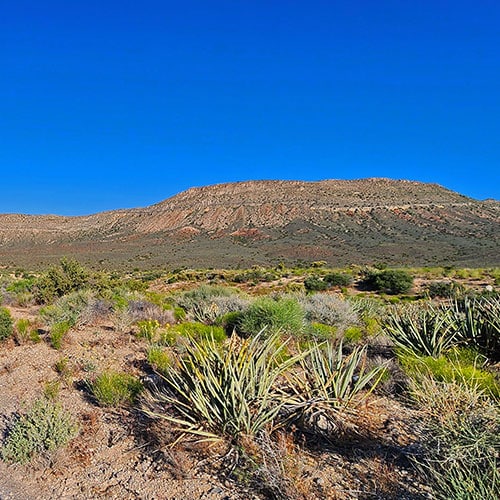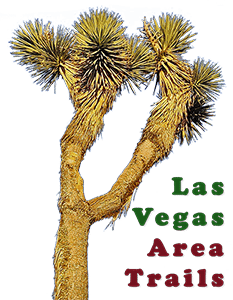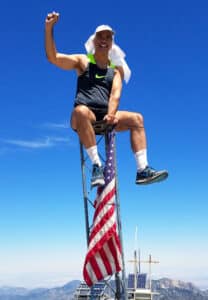I’ve been using this bluff for years as a landmark. It’s been valuable for finding my way back from pathless wilderness high points both throughout Lovell Canyon and in the Rainbow Mountains. Over time, I began to naturally refer to it as the “Lovell Canyon Landmark Bluff“.
The Landmark Bluff can be seen from such high points as:
Over time, I began to wonder, “What’s up there on that bluff?” “What do all these distant points look like from Landmark Bluff.”
This adventure is the initial exploration of Landmark Bluff! Starting on the East side of the bluff at Lovell Canyon & Rainbow Spring Roads, the route makes a circuit around the South end of the bluff to the West side. The West side perspective is entirely different from the East side perspective seen from Lovell Canyon. The route continues to summit the South end of the bluff, then descends to explore more of the West side before returning to the starting point.
In the process, there are some cool discoveries on the wilder West side of Landmark Bluff!
Landmark Bluff is huge and will require at least two additional adventures:
Take Hwy 160 from Las Vegas toward Pahrump. The highway ascends over a “hump” (the Potosi Mountain area). There’s a saying around here, “Over the hump to Pahrump”. Well, you’ve just traveled over that hump. Around 4-5 miles from the point where the highway begins to descend toward Pahrump there is a well-marked sign on the right for Lovell Canyon Road. As you enter Lovell Canyon, that large bluff to your left is Landmark Bluff.
After parking at the intersection of Lovell Canyon & Rainbow Springs Road (lots of parking available), I crossed Lovell Canyon Road toward Landmark Bluff. There’s a wash immediately across Lovell Canyon Road that parallels that road all the way to Highway 160. After heading down the wash for about 30 yards, I ascended a ridge toward Landmark Bluff for the better ridge views. Closer to the base of the bluff where the incline begins to sharply increase toward the summit, I took a left and headed South along the upper base of the bluff. There are spectacular views at that elevation including Highway 160 all the way to Potosi Mountain, the Rainbow Mountains Upper Crest Ridgeline and the Wilson Ridgeline, all across Lovell Canyon on the East side.
When you reach the Southern end of Landmark Bluff and begin circling around the South side above Highway 160, the length of the South side is surprising. Every time it appears you’ve reached the South edge, look ahead to see another ridgeline descending further to the South. There are three ridgelines and a canyon on the South side of the bluff. A promising summit approach ascends from the canyon. But today the goal was the circle around to the West side of the bluff to explore the lower terrain there. The South side also reveals a spectacular view of the Nopah Range.
It’s clear that on the Southern and Western side of Landmark Bluff you are no longer in the regulated Lovell Canyon area. Recall all those “No Target Shooting” signs on Lovell Canyon Road? Well, on the South and West side of Landmark Bluff target shooting is allowed. There are parking areas far below near Highway 160 with targets a lot of debris left during prior target practice sessions. And, I found more than one target over a thousand feet above the lower parking areas along the upper base of the bluff. You might want to avoid traversing this area on weekends when there are likely to be shooters below. There were the sounds of firearms across highway 160 where it appears there is a more active target area. The gun ranges and much debris continue around the West side of Landmark Bluff. I even found a lonely bowling pin far from the road below.
There is an unpaved, unmarked power line maintenance road along the South side of the bluff running parallel and just a couple hundred feet from Highway 160. There’s another unpaved road skirting the lower Western base of the bluff in a North/South direction. Incidentally, I used these roads for a rapid return.
Just as the South side of Landmark Bluff is surprising in its length and with the hidden canyon approach to the summit, the West side of the bluff holds more surprises. When you’re looking at the bluff on the East side from Lovell Canyon, it appears to be a straight line ridge. Not on the West side! There are two large canyon inlets on the West side of the bluff. Both hold potential approaches to the summit. The canyon to the North looks the most hopeful for summit approaches.
As you round Landmark Bluff and head North along its West side a number of unique and spectacular views open. There’s upper Lovell Canyon with Harris Mountain and Griffith Peak. But in addition, you can see Charleston Peak and the ridgeline leading all the way from Griffith Peak. And to the West, there is Pahrump with a backdrop of the mountain ranges on the East side of Death Valley: Black Mountains and Funeral Mountains…even the Grapevine Mountains further North. And beyond those mountain ranges, in the dim distance, you can catch a glimpse of the Panamint Range on the West side of Death Valley with Telescope Peak, Wildrose Peak, Aguereberry Point and Skidoo Ghost Town (requires a clear day and careful observation). And, the Nopah Range continues to be visible in all its glory.
That first canyon you encounter on the West side of the bluff after rounding the South end, holds a couple surprises. First, there is a large cave on the North side of the canyon, you can’t miss it. A road leads to the mouth of the cave mid-way up the ridge. That cave would be a great future adventure. It would be interesting to see how far in it goes, but be prepared with some caving experience and precautions.
On the South side of the Southern canyon there are at least two summit approach gullies. I took one up to the bluff’s summit there and returned by the other (see the video). Both are class 2 climbing (basically a steep walk on loose rock, but with no significant exposure and no need to scale boulders of cliff walls). Views from the Southern summit are far more incredible than the views from below.
With the exception of the two summit approach gullies I found in the Southern canyon, the upper rims surrounding the canyon appear to be guarded by a series of vertical cliff walls. There are some potential summit routes, but the terrain looks pretty vertical near the summit!
One would think by looking at the relatively even summit line of Landmark Bluff from the East side in Lovell Canyon that traversing the summit ridge from North to South would be an easy walk. Not so when you’re up there! There are some vertical barriers that might be skirted without any rock climbing, but discovering potential class 2-3 routes will require more careful further exploration. There are many exposed ledges along the way. A good North/South summit route along Landmark Bluff will be a fun puzzle to decode. On this day I descended from the Southern summit and connected with the road on the Western base of the bluff.
The unpaved road skirting the lower West side of Landmark Bluff divides at the next canyon to the North. The left branch continues toward the North end of the bluff. The right branch heads into the Northern canyon. That road eventually ends, but a trail continues all the way to Mule Spring, marked by a large palm tree the a spring-fed oasis. The oasis is surrounded by a wall of cliffs that appear to prevent further advance up the canyon. However, further exploration of the trail might reveal a passageway through the cliff walls. I look at a possible route in the video.
With the exception of the cliff walls creating a box canyon above Mule Spring, the West side further down that canyon appears to hold multiple summit approaches. There’s a much more gradual summit incline along the Western rim of that canyon.
On this mid-November day, I turned around at Mule Spring in order to make it back to Lovell Canyon before sunset. The return trip was fast! I headed back down the Western road and took a left onto the powerline maintenance road just short of highway 160, then took that road back to Lovell Canyon. Just before Lovell Canyon Road you can take a left onto a canyon wash road that runs parallel to Lovell Canyon Road. The wash road will take you all the way to the intersection of Lovell Canyon and Rainbow Spring Roads. The wash road is far more interesting than walking or running along Lovell Canyon Road, and has no traffic!
Landmark Bluff is huge, and holds many fascinating areas to explore. A few of these include:
It helps knowing that however long you spend exploring the Western side of the bluff, the roads provide a quick route back to your start point in Lovell Canyon. It took me just a little over an hour to make it all the way from Mule Spring on the West side of Landmark Bluff back to my start point on Lovell Canyon and Rainbow Spring road.



Return often to experience one new adventure each week! From the home page scroll to “Most Recent Adventures“. More about David Smith…
The trail adventures on this website require proper conditioning, preparation and safety precautions. There are many factors beyond our control including weather conditions, unstable ground, loose rocks, insects and snakes, people you may encounter, your own level of physical conditioning, the potential of getting lost just to mention a few. While this site offers guidance, helpful tips, direction and training, the reader assumes full responsibility for whatever may occur during their trail adventure. Have fun and be safe!